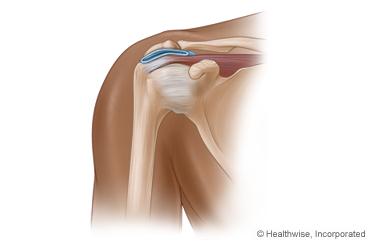Dislocated Shoulder in Children: Care Instructions
Overview

When the upper arm comes out of the shoulder socket, it is called a dislocated shoulder.
After the doctor puts the shoulder back in place, the doctor may put your child's arm in a sling or brace to
keep it from moving.
Exercise and physical therapy can help the shoulder strengthen and move normally again. You can help your
child get better with rest and home treatment.
If the shoulder keeps coming out of place, talk to your doctor about surgery. It can prevent dislocations.
Your child may have had a sedative to help them relax. Your child may be unsteady after having sedation. It
may take a few hours for the medicine's effects to wear off. Common side effects of sedation include nausea,
vomiting, and feeling sleepy or cranky.
The doctor has checked your child carefully. But problems can develop later. If you notice any problems or
new symptoms, get medical treatment right away.
Follow-up care is a key part of your child's treatment and safety. Be sure to make and go to all
appointments, and call your doctor if your child is having problems. It's also a good idea to know your
child's test results and keep a list of the medicines your child takes.
How can you care for your child at home?
-
If your doctor put your child's arm in a sling or shoulder immobilizer, make sure your child wears it as
directed.
-
Give pain medicines exactly as directed.
-
If the doctor gave your child a prescription medicine for pain, give it as prescribed.
-
If your child is not taking a prescription pain medicine, ask your doctor if your child can take an
over-the-counter medicine. Read and follow all instructions on the label.
-
Put ice or a cold pack on your child's shoulder for 10 to 20 minutes at a time. Try to do this every 1 to
2 hours for the next 3 days (when your child is awake). Put a thin cloth between the ice and your child's
skin.
-
You may use warm packs after the first 3 days for 15 to 20 minutes at a time. This can ease pain.
-
If your doctor gave your child exercises to do at home, help your child do them exactly as your doctor
told you.
-
Do not let your child do anything that makes the pain worse.
When should you call for help?
 Call 911
anytime you think your child may need emergency care. For example, call if:
Call 911
anytime you think your child may need emergency care. For example, call if:
Call your doctor now or seek immediate medical care if:
Watch closely for changes in your child's health, and be sure to contact your doctor if:
Current as of: July 17, 2023
Content Version: 14.0
Care instructions adapted under license by your
healthcare professional. If you have questions about a medical condition or this instruction, always ask
your healthcare professional. Healthwise, Incorporated disclaims any warranty or liability for your use of
this information.